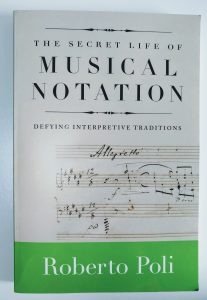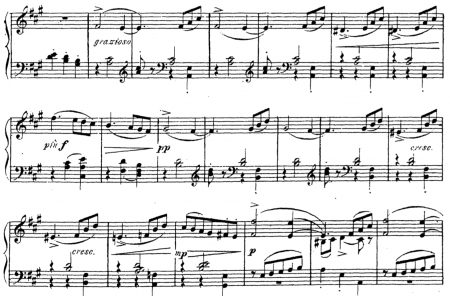
The secret life of hairpins
In The Secret Life of Musical Notation, Roberto Poli examines a number of notational conventions—hairpins, sforzandi, rinforzandi, pedals, stretti and rhythmic values—that have perplexed him as a performer, and led him to investigate the possibility that they don’t mean what we assume them to mean.
I found the chapter on hairpins very interesting, and the evidence for there being a problem is persuasive: he shows a number of examples from Chopin’s work where the hairpins don’t make a lot of sense, either because they’re redundant (they show a hairpin as well as a diminuendo, for example) or because they contradict the musical sense: a “diminuendo” hairpin just at the point where you are getting to the high point of a phrase, and to taper off seems expressively illogical.
When is a hairpin not a hairpin?
His conclusion is that hairpins, among some composers and in a certain time period, denoted not [simply] increases or decreases in volume, but agogics, i.e. expressive timing. What we think of as a “crescendo” hairpin would mean pulling out (i.e. slowing down) towards the open end of the hairpin. A “diminuendo” hairpin would mean essentially a tenuto where the open end was, recovering normal tempo towards the end. Two hairpins together, with the open end in the middle, would mean treating the tempo of the bar with rubato. I’m reducing the arguments a little (the chapter is nearly 70 pages long), but that’s roughly it. Importantly, what appear to be accents might in fact be mini hairpins, and as such, are an alternative sign for what we would normally expect to be represented by a tenuto.
As convincing as the arguments are, It all sounds a bit too much like an engaging conspiracy theory to be true, but then he quotes Riemann’s Die Elemente der musikalischen Äesthetik (1900), where
hairpins are described as affecting both dynamic and agogic coordinates. Riemann explained that the symbol might serve different purposes, its agogic function only strengthening the dynamic one and vice versa. He formulated that, should the context in which the hairpin is found convey the necessity, one or the other function can be abandoned, as long as this would not incur a great loss of either parameter. (Poli, 2010, p. 66)
The Lilac Fairy Attendants’ Hairpins
As it happened, the day after I read the chapter on hairpins, I was down to play the Lilac Fairy Attendants from Sleeping Beauty on an Easter School, a piece that is really horrible to play on the piano, and doesn’t get any less horrible when you’ve done it at every summer school for the last 30 years. I was still in two minds about Poli’s thesis about hairpins, but I thought, let’s see how his theory fares on this piece.
Whether or not Tchaikovsky fits in to the league of composers or periods when hairpins or “accents” could mean agogics or not, I am utterly convinced that this is a better way to read the score than any way I have done in the past.
Using Poli’s analyses, one could interpret the “accents” over those notes as meaning tenuto marks, rather than accents. Do that once, and tell me you’re not convinced: what sense does it make to have accents on those notes when the marking is grazioso, and later pianissimo? For years, I’ve obeyed the music and put a little accent of sorts on that note, but when you get to the hairpin starting in bar six, why on earth would you get louder and accent those notes in music like this?
But change those accents to tenuto marks, and pull out the music towards the F#, and give slightly more tenuto on the following B, and then on the bottom line, pull out towards the C#, and it all makes beautiful musical sense. You can play this music without any dynamic accents at all, only agogic ones, and it begins to sound like music again.
Likewise, the accent on the D in voice 2 in the RH in the penultimate bar. A tenuto there makes perfect sense within the waltz, because there would be a slight hold there in the movement, but an accent is neither musical, nor does it give the right tempo feel to the bar that would be appropriate. As Poli points out, we are so conditioned by later performance practice not to conflate dynamics with agogics, that it’s difficult to imagine a time when it was considered perfectly normal and musical to do so.
I compared the orchestral score to Siloti’s arrangement. Siloti has a narrowing hairpin in the last few bars, where the orchestra doesn’t, and it makes musical sense to pull out towards the end a bit. A conductor would do this without needing to be told in the score, but perhaps Siloti wrote his hairpin in the score to give an indication of what would be determined in orchestral practice.
Another rather interesting thing is that the tendency towards metronomic tempi, and the going-out-of-fashion of this kind of agogics, has seeped into ballet as well. It’s a delightful rarity to work with a ballet teacher who lives and breathes expressive timing, but that may be a side-effect of performance practice in music rather than ballet. People my age will remember a time when to slow down at the end of a piece of early music was like wearing brown shoes in the city. We live in less dictatorial times I think, thanks to Taruskin’s diatribes against such things in Text and Act for example, but I hadn’t realised until this Sleeping Beauty experience how much my reading of notation followed such carefully self-policed rules.


